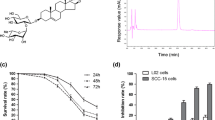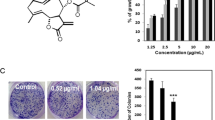Abstract
PKC inhibitor safingol suppressed the growth of human oral squamous cell carcinoma (SCC) cells significantly at concentrations that inhibit PKC isoforms. Safingol inhibited the translocation of PKC following treatment with 12-o-tetradecanoylphorbol 13-acetate (TPA) in PKC α-EGFP-transfected cells, but not in PKC β-EGFP- transfected cells, indicating selective inhibition for PKC α in oral SCC cells. Flow cytometric analysis and DNA analysis by agarose gel electrophoresis revealed an increase in the proportion of sub-G1 cells and DNA fragmentation in safingol-treated cells. Mitochondrial membrane potential was decreased, and cytochrome c was released from mitochondria. However, the safingol-induced cell death was not accompanied by activation of caspase 3 and cleavage of poly (ADP-ribose) polymerase (PARP). The broad-spectrum caspase inhibitor BD-fmk failed to prevent safingol-induced cell death. Another apoptogenic factor endonuclease G, but not apoptosis-inducing factor (AIF), was also released from mitochondria and translocated to the nucleus. These results suggest that PKC α inhibitor safingol induces an endonuclease G- mediated apoptosis in a caspase-independent manner.
Similar content being viewed by others
Abbreviations
- AIF:
-
apoptosis-inducing factor
- PARP:
-
poly (ADP-ribose) polymerase
- PKC α:
-
protein kinase C α
- SCC:
-
squamous cell carcinoma
References
Mellor H, Parker PJ. The extended protein kinase C superfamily. Biochem J 1998; 332: 281–292.
Musashi M, Ota S, Shiroshita N. The role of protein kinase C isoforms in cell proliferation and apoptosis. Int J Hematol 2000; 72: 12–19.
Couldwell WT, Uhm JH, Antel JP, Yong VW. Enhanced protein kinase C activity correlates with the growth rate of malignant gliomas in vitro. Neurosurgery 1991; 29: 880–887.
Nishizuka Y. Intracellular signaling by hydrolysis of phospholipids and activation of protein kinase C. Science 1992; 258: 607–614.
Soh JW, Lee YS, Weinstein IB. Effects of regulatory domains of specific isoforms of protein kinase C on growth control and apoptosis in MCF-7 breast cancer cells. J Exp Ther Oncol 2003; 3: 115–126.
Arany I, Adler-Storthz K, Chen Z, Tyring SK, Brysk H, Brysk MM. Differentiation markers in oral carcinoma cell lines and tumors. Anticancer Res 1997;17: 4607–4610.
Martinez-Gimeno C, Diaz-Meco MT, Dominguez I, Moscat J. Alterations in levels of different protein kinase C isotypes and their influence on behavior of squamous cell carcinoma of the oral cavity: Epsilon PKC, a novel prognostic factor for relapse and survival. Head Neck 1995; 17: 516–525.
Rajewski RA, Kosednar DG, Matches TA, Wong OS, Burchett K, Thakker K. Stereo-specific analysis of a novel protein kinase C inhibitor. J Pharm Biomed Anal 1995; 13: 247–253.
Choe Y, Jung H, Khang I, Kim K. Selective roles of protein kinase C isoforms on cell motility of GT1 immortalized hypothalamic neurones. J Neuroendocrinol 2003; 15: 508–515.
Uemura K, Aki T, Yamaguchi K, Yoshida K. Protein kinase C-epsilon protects PC12 cells against methamphetamine-induced death: possible involvement of suppression of glutamate receptor. Life Sci 2003; 72: 1595–1607.
Schwartz GK, Haimovitz-Friedman A, Dhupar SK, et al. Potentiation of apoptosis by treatment with the protein kinase C-specific inhibitor safingol in mitomycin C-treated gastric cancer cells. J Natl Cancer Inst 1995; 87: 1394–1399.
Schwartz GK, Ward D, Saltz L, et al. A pilot clinical/pharmacological study of the protein kinase C-specific inhibitor safingol alone and in combination with doxorubicin. Clin Cancer Res 1997; 3: 537–543.
Hoffmann TK, Leenen K, Hafner D, et al. Antitumor activity of protein kinase C inhibitors and cisplatin in human head and neck squamous cell carcinoma lines. Anticancer Drugs 2002; 13: 93–100.
Li P, Nijhawan D, Budihardjo I, et al. Cytochrome c and dATP-dependent formation of Apaf-1/caspase-9 complex initiates an apoptotic protease cascade. Cell 1997; 91: 479–489.
Susin SA, Lorenzo HK, Zamzami N, et al. Molecular characterization of mitochondrial apoptosis-inducing factor. Nature 1999; 397: 441–446.
Li LY, Luo X, Wang X. Endonuclease G is an apoptotic DNase when released from mitochondria. Nature 2001; 412: 95–99.
van Loo G, Schotte P, van Gurp M, et al. Endonuclease G: A mitochondrial protein released in apoptosis and involved in caspase-independent DNA degradation. Cell Death Differ 2001; 8: 1136–1142.
Saelens X, Festjens N, Vande Walle L, van Gurp M, van Loo G, Vandenabeele P. Toxic proteins released from mitochondria in cell death. Oncogene 2004; 23: 2861–2874.
Hasina R, Matsumoto K, Matsumoto-Taniura N, Kato I, Sakuda M, Nakamura T. Autocrine and paracrine motility factors and their involvement in invasiveness in a human oral carcinoma cell line. Br J Cancer 1999; 80: 1708–1717.
Blatt NB, Glick GD. Signaling pathways and effector mechanisms pre-programmed cell death. Bioorg Med Chem 2001; 9: 1371–1384.
Budihardjo I, Oliver H, Lutter M, Luo X, Wang X. Biochemical pathways of caspase activation during apoptosis. Annu Rev Cell Dev Biol 1999; 15: 269–290.
Hengartner MO. The biochemistry of apoptosis. Nature 2000; 407: 770–776.
Amin HM, Ergin M, Denning MF, Quevedo ME, Alkan S. Characterization of apoptosis induced by protein kinase C inhibitors and its modulation by the caspase pathway in acute promyelocytic leukaemia. Br J Haematiol 2000; 110: 552–562.
Ahn EH, Schroeder JJ. Sphingoid bases and ceramide induce apoptosis in HT-29 and HCT-116 human colon cancer cells. Exp Biol Med 2002; 227: 345–353.
Park MT, Kang JA, Choi JA, et al. Phytosphingosine induces apoptotic cell death via caspase 8 activation and Bax translocation in human cancer cells. Clin Cancer. Res 2003; 9: 878–885.
Du C, Fang M, Li Y, Li L, Wang X. Smac, a mitochondrial protein that promotes cytochrome c-dependent caspase activation by eliminating IAP inhibition. Cell 2000; 102: 33–42.
Verhagen AM, Coulson EJ, Vaux DL. Inhibitor of apoptosis proteins and their relatives: IAPs and other BIRPs. Genome Biol 2001; 2: reviews 3009.1–3009.10
Suzuki Y, Imai Y, Nakayama H, Takahashi K, Takio K, Takahashi R. A serine protease, HtrA2, is released from the mitochondria and interacts with XIAP, inducing cell death. Mol Cell 2001; 8: 613–621.
Hegde R, Srinivasula SM, Zhang Z, et al. Identification of Omi/HtrA2 as a mitochondrial apoptotic serine protease that disrupts inhibitor of apoptosis protein-caspase interaction. J Biol Chem 2002; 277: 432–438.
Liu X, Zou H, Slaughter C, Wang X. DFF, a heterodimeric protein that functions downstream of caspase-3 to trigger DNA fragmentation during apoptosis. Cell 1997; 89: 175–184.
Sakahira H, Enari M, Nagata S. Cleavage of CAD inhibitor in CAD activation and DNA degradation during apoptosis. Nature 1998; 391: 96–99.
Halenbeck R, MacDonald H, Roulston A, Chen TT, Conroy L, Williams LT. CPAN, a human nuclease regulated by the caspase-sensitive inhibitor DFF45. Curr Biol 1998; 23: 537–540.
Basnakian AG, Ueda N, Hong X, Galitovsky VE, Yin X, Shah SV. Ceramide synthase is essential for endonuclease-mediated death of renal tubular epithelial cells induced by hypoxia-reoxygenation. Am J Physiol Renal Physiol 2005; 288: F308-F314.
Oltvai ZN, Milliman CL, Korsmeyer SJ. Bcl-2 heterodimerizes in vivo with a conserved homolog, Bax, that accelerates programmed cell death. Cell 1993; 74: 609–619.
Rosse T, Olivier R, Monney L, et al. Bcl-2 prolongs cell survival after Bax-induced release of cytochrome c. Nature 1998; 391: 496–509.
Murphy KM, Ranganathan V, Farnsworth ML, Kavallaris M, Lock RB. Bcl-2 inhibits Bax translocation from cytosol to mitochondria during drug-induced apoptosis of human tumor cells. Cell Death Differ 2000; 7: 102–111.
Shirahama T, Sakakura C, Sweeney EA, et al. Sphingosine induces apoptosis in androgen-independent human prostatic carcinoma DU-145 cells by suppression of bcl-X(L) gene expression. FEBS Lett 1997; 407: 97–100.
Kedderis LB, Bozigian HP, Kleeman JM, et al. Toxicity of the protein kinase C inhibitor safingol administered alone and in combination with chemotherapeutic agents. Fundam Appl Toxicol 1995; 25: 201–217.
Author information
Authors and Affiliations
Corresponding author
Rights and permissions
About this article
Cite this article
Hamada, M., Sumi, T., Iwai, S. et al. Induction of endonuclease G-mediated apopotosis in human oral squamous cell carcinoma cells by protein kinase C inhibitor safingol. Apoptosis 11, 47–56 (2006). https://doi.org/10.1007/s10495-005-3348-z
Published:
Issue Date:
DOI: https://doi.org/10.1007/s10495-005-3348-z




